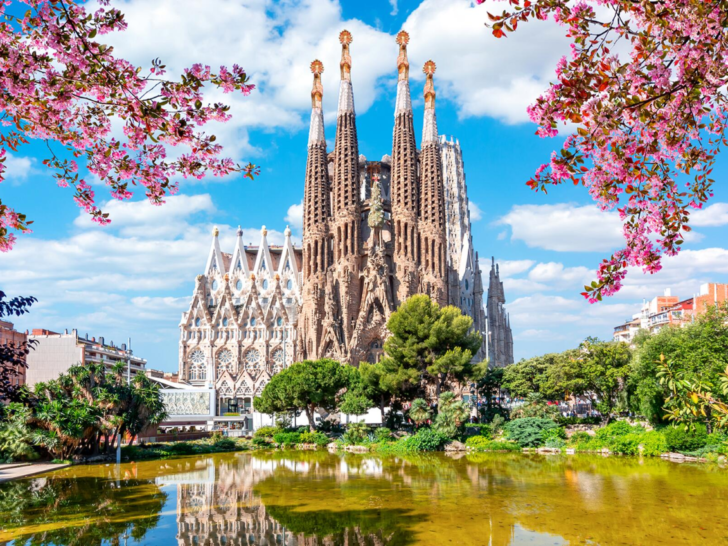Barcelona is a vibrant city, blending ancient history, striking architecture, and a lively atmosphere that makes it a dream for travelers. Whether you’re a first-time visitor or a frequent traveler to Spain, Barcelona offers countless experiences to discover. Here’s a list of 15 must-see spots that will make your Barcelona trip unforgettable, each offering a unique insight into the city’s charm and culture. Let’s dive into the best of Barcelona, starting with its iconic churches and bustling neighborhoods to the serene parks and lively beaches.
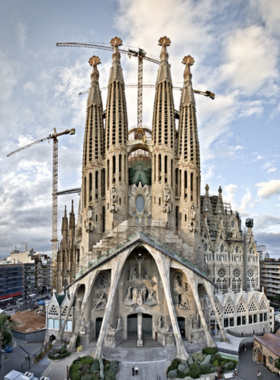
La Sagrada Família
Address: C/ Mallorca, 401
| Type | Churches/Religious Sites, Sightseeing |
| Time to Spend | 1 to 2 hours |
History and Significance: La Sagrada Família is an iconic basilica designed by Antoni Gaudí, and it has been under construction since 1882. It is a UNESCO World Heritage Site, representing Gaudí’s architectural genius and his vision of blending nature with sacred geometry. The basilica reflects both Catalan Modernism and Gothic styles.
What to Expect: Expect awe-inspiring architecture, with towering spires, intricate facades, and beautifully designed interiors. The basilica is renowned for its unique style, featuring symbolic sculptures, organic shapes, and colorful stained glass. Visitors can explore the basilica’s interior and enjoy breathtaking views from its towers.
Visitor Information: The basilica is located in the Eixample district. Tickets are available online, and it’s best to book in advance due to high demand. Opening hours vary, but it generally opens from 9 AM to 6 PM. Guided tours are available for a deeper understanding of its history and architecture.
Antoni Gaudí’s La Sagrada Família is an architectural marvel in Barcelona. This Gothic-style cathedral with a twist is still under construction, making it one of the city’s most famous works in progress. Its unique design, with detailed towers and colorful stained glass, captures the imagination. Visitors can explore the church’s inspiring interiors and get a view from the towers. Just a 20-minute walk north will lead you to the Hospital de Sant Pau, another gem showcasing Catalan art nouveau style, adding a beautiful complement to your visit.
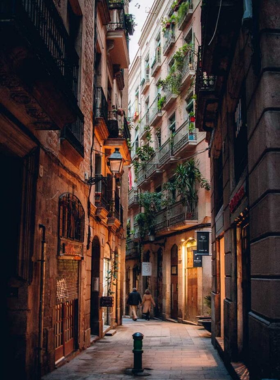
Gothic Quarter (Barri Gòtic)
Address: Gothic Quarter
| Type | Neighborhood/Area, Sightseeing |
| Time to Spend | 1 to 2 hours |
History and Significance: The Gothic Quarter is the heart of old Barcelona, dating back to Roman times. This area is full of narrow medieval streets, hidden squares, and beautiful gothic architecture. It’s home to the Barcelona Cathedral and many other historical buildings, showcasing the city’s rich history and heritage.
What to Expect: You’ll be surrounded by a maze of cobbled streets, medieval churches, and lively plazas. Expect charming cafes, local boutiques, and plenty of photo-worthy spots. Explore hidden squares and discover remnants of Roman walls and buildings, adding to the area’s historic appeal.
Visitor Information: The Gothic Quarter is centrally located, with easy access from Las Ramblas. It’s free to explore, but you can join a guided tour to learn more about its history. Be sure to visit the Barcelona Cathedral and other landmarks like Plaça Sant Jaume and Plaça del Rei.
The Gothic Quarter is one of Barcelona’s oldest and liveliest neighborhoods, full of Roman and medieval architecture. Wander its narrow streets to find quaint cafes, vibrant shops, and historic churches like the Barcelona Cathedral. Be sure to visit Plaça de la Seu and Plaça Sant Felip Neri, where you can see scars from a bombing during the Spanish Civil War. Travelers love the Gothic Quarter’s magical atmosphere, especially at night, with its lit-up buildings and lively spots for dining and shopping.
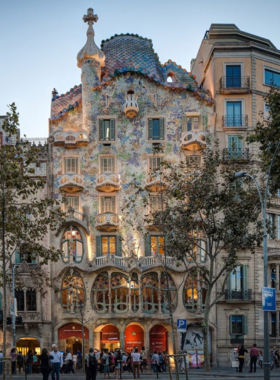
Casa Batlló
Address: Passeig de Gracia, 43
| Type | Sightseeing |
| Time to Spend | 1 to 2 hours |
History and Significance: Casa Batlló is one of Antoni Gaudí’s most famous buildings, completed in 1906. It’s known for its whimsical design, featuring curved lines, colorful tiles, and skeletal-like balconies. The house was remodeled by Gaudí for the Batlló family and remains a masterpiece of modernist architecture.
What to Expect: Expect to see a building that looks almost like a living organism, with its undulating façade and colorful mosaic tiles. Inside, you’ll find rooms filled with organic shapes, curving walls, and breathtaking stained glass. The rooftop offers panoramic views of the city.
Visitor Information: Casa Batlló is located on Passeig de Gràcia, a major avenue in Barcelona. Tickets are available online and in-person, with several pricing options for tours. It opens daily from 9 AM to 9 PM. Audio guides and augmented reality experiences are available to enhance your visit.
Casa Batlló is one of Gaudí’s most famous works, featuring vibrant colors and tile work inspired by Catalan legend. The façade is decorated with balconies shaped like skulls, representing a dragon’s victims, while the roof mimics the creature’s scales. If you visit between spring and fall, you can catch a “Magical Nights” concert on the rooftop, which offers incredible views of the city. This landmark, a UNESCO World Heritage Site, is both a piece of art and a fun stop to add to any travel itinerary.
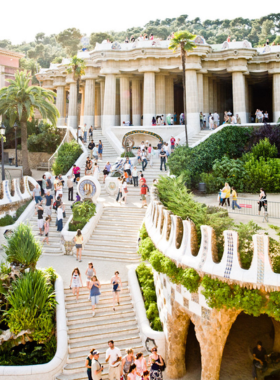
Park Güell
Address: Carrer Olot
| Type | Parks and Gardens, Sightseeing |
| Time to Spend | 2 hours to Half Day |
History and Significance: Park Güell was originally intended as a residential project but later became a public park. Designed by Antoni Gaudí, it showcases his signature style, including colorful mosaics, serpentine benches, and whimsical structures. It is a UNESCO World Heritage Site and an iconic example of Catalan Modernism.
What to Expect: Visitors can expect stunning panoramic views of Barcelona, a winding pathway surrounded by lush greenery, and whimsical architectural elements. Look out for the colorful mosaic dragon at the park’s entrance and Gaudí’s famous ceramic bench that winds around the terrace.
Visitor Information: Park Güell is located in the Gràcia district. Admission is free for general park access, but there is a fee to visit the Monumental Zone, which includes the main architectural attractions. It opens from 8:30 AM to 6:15 PM, with tickets available online for convenience.
Originally designed as a housing project for Barcelona’s elite, Park Güell is a colorful park that feels straight out of a storybook. Located on a hillside, it offers amazing views of the city, winding pathways, and Gaudí’s unique sculptures that blend into the landscape. The park is known for its bright ceramic mosaics and the famous lizard statue, which makes for great photos. Just a short walk up from Park Güell, the Bunkers del Carmel viewpoint provides a quiet spot to watch the sunset.
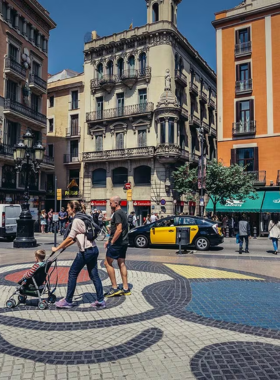
Las Ramblas
Address: Las Ramblas
| Type | Free, Neighborhood/Area, Shopping |
| Time to Spend | 1 to 2 hours |
History and Significance: Las Ramblas is a famous tree-lined street in the heart of Barcelona. It stretches 1.2 km from Plaça de Catalunya to the Christopher Columbus Monument. Once a stream, it has evolved into a vibrant pedestrian promenade filled with shops, restaurants, and street performers.
What to Expect: Las Ramblas is always bustling with activity, from street performers to flower stalls. Expect crowds of tourists and locals alike, shopping and enjoying the lively atmosphere. Along the way, you’ll encounter restaurants, markets, and beautiful buildings.
Visitor Information: Las Ramblas is centrally located, easily accessible by metro or walking from most city areas. While walking down the boulevard is free, you can stop by various attractions along the way, including the Mercat de la Boqueria. It’s best to visit during the daytime or early evening to avoid large crowds.
Las Ramblas is Barcelona’s busiest boulevard, running through the city center. This tree-lined street is ideal for people-watching, shopping, and enjoying street performances. Las Ramblas has everything from souvenir shops to cafes with outdoor seating, where you can grab a drink and watch the lively surroundings. With its vibrant nightlife scene, it’s a popular spot for starting a night out in the city. Keep an eye on your belongings here, as it’s also a busy area for pickpockets.
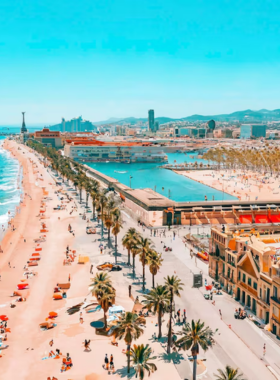
Barceloneta Beach
Address: Moll De Mestral
| Type | Beaches, Free, Neighborhood/Area, Sightseeing |
| Time to Spend | 2 hours to Half Day |
History and Significance: Barceloneta Beach was originally developed in the 18th century as a fishing village. In the 1990s, it was transformed into a popular urban beach, providing a relaxing spot for locals and tourists. Today, it remains one of Barcelona’s most iconic beaches.
What to Expect: Expect a lively beach atmosphere, with sunbathers, swimmers, and people playing beach volleyball. The beach is lined with cafes and seafood restaurants. The Mediterranean water is usually calm, perfect for a relaxing swim or a refreshing walk along the shore.
Visitor Information: Barceloneta Beach is easily accessible from the Barceloneta Metro station. It’s free to access, and you can rent lounge chairs and umbrellas from local vendors. The beach is busy, especially in the summer, so it’s best to visit early or late in the day for a more relaxed experience.
Barcelona’s sunny coastline is best experienced at Barceloneta Beach. It’s a hotspot for both locals and tourists, where you can sunbathe, swim, or enjoy a meal at a beachfront restaurant. For a quieter beach day, head north to Playa de Bogatell, which tends to be less crowded and more laid-back. Barceloneta Beach is not just for beachgoers—it’s also surrounded by bars and cafes, so it’s easy to spend a whole day soaking up the Mediterranean vibes.
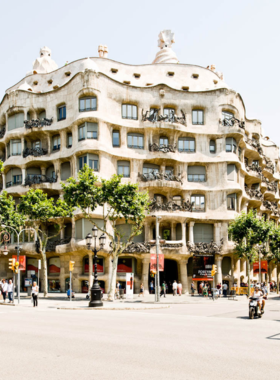
Casa Milà (La Pedrera)
Address: 92 Passeig de Gracia
| Type | Museums, Sightseeing |
| Time to Spend | 2 hours to Half Day |
History and Significance: Casa Milà, also known as La Pedrera, was designed by Antoni Gaudí and completed in 1912. This iconic building is known for its undulating stone façade and wrought-iron balconies. It’s a UNESCO World Heritage Site and represents Gaudí’s innovative approach to modernist architecture.
What to Expect: Expect a visually striking building with curvy walls, a surreal roof terrace, and intricate details. Inside, you’ll find a museum showcasing Gaudí’s work and the building’s history. The rooftop features chimneys that resemble sculptures, offering great views of the city.
Visitor Information: Located on Passeig de Gràcia, La Pedrera is open from 9 AM to 8:30 PM. Tickets are available online, and audio guides or guided tours are available to enrich your experience. It’s a must-see for architecture lovers and those interested in Gaudí’s works.
Casa Milà, also known as La Pedrera, is another of Gaudí’s masterpieces with its undulating stone façade and rooftop chimneys. The building’s nickname, “The Quarry,” refers to its stony, fortress-like appearance. Inside, you’ll find exhibits about Gaudí’s work and design, and the rooftop offers a great view of the city. La Pedrera is both a cultural center and a UNESCO World Heritage Site, making it a fascinating mix of art, history, and architecture.
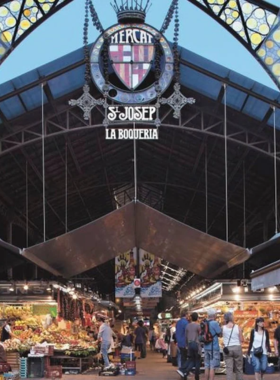
Mercat de la Boqueria
Address: Plaza de la Boqueria
| Type | Free, Shopping |
| Time to Spend | 1 to 2 hours |
History and Significance: Boqueria Market, established in the 13th century, is one of the oldest markets in Barcelona. It’s a vibrant hub for fresh produce, meats, fish, and local delicacies, offering a true taste of Catalan culture. It’s a popular spot for both locals and tourists.
What to Expect: Expect a colorful and lively atmosphere with stalls selling fresh fruit, seafood, meats, and baked goods. It’s the perfect place to sample Spanish delicacies, such as jamón ibérico, seafood tapas, and fresh juices. The market can get crowded, especially at lunchtime.
Visitor Information: Located on Las Ramblas, Mercat de la Boqueria is open daily from 8 AM to 8:30 PM. It’s free to enter, and you can easily browse the various stalls. For a more in-depth experience, some vendors offer cooking classes or food tours.
Boqueria Market is a colorful, historic market offering a variety of Spanish delicacies. With stalls selling fresh produce, meats, and traditional snacks, it’s a foodie’s dream come true. It’s also a great place to try local favorites like jamón ibérico and manchego cheese. The market is located near Las Ramblas, so it’s easy to stop by during a day of sightseeing. Grab a fresh juice or snack while you explore and enjoy the vibrant atmosphere of one of Barcelona’s oldest markets.
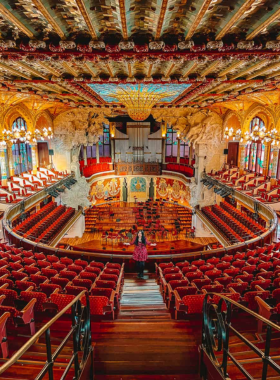
Palau de la Música Catalana
Address: Palau De La Música, 4
| Type | Entertainment and Nightlife, Museums |
| Time to Spend | 1 to 2 hours |
History and Significance: Built between 1905 and 1908 by architect Lluís Domènech i Montaner, Palau de la Música Catalana is a stunning concert hall and a UNESCO World Heritage Site. It showcases Catalan modernist architecture with intricate mosaics, stained glass, and sculptures.
What to Expect: Expect a rich cultural experience, with ornate architecture that’s both colorful and striking. The concert hall is renowned for its acoustic quality, offering performances ranging from classical music to jazz. Be sure to admire the grand stained-glass skylight.
Visitor Information: Palau de la Música is located in the El Born district. It is open for tours and concerts, with tickets available online. Tours run daily, and performances are held regularly in the evening. Check the schedule for specific concert dates.
This concert hall, known for its stunning Catalan art nouveau design, was built by Lluis Domènech i Montaner and is now a UNESCO World Heritage Site. The building’s colorful stained glass and intricate mosaics make it a sight to see, even if you’re not catching a concert. Guided tours are available to explore the hall’s history and its role in Barcelona’s cultural scene. It’s a lesser-known gem that will surprise you with its detailed design and artistic appeal.
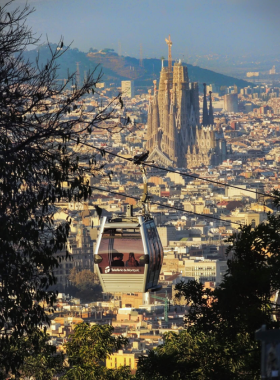
Montjuïc Hill
Address: Hill in Spain
| Type | Neighborhood/Area, Sightseeing |
| Time to Spend | 1 to 2 hours |
History and Significance: Montjuïc Hill is a prominent landmark in Barcelona, offering a rich history. From ancient fortresses to the 1992 Olympic Games, it has been a hub for cultural and sporting events. It offers panoramic views of the city and the sea.
What to Expect: Expect to see a range of attractions, from Montjuïc Castle to the Magic Fountain, along with several museums. Take a cable car ride for spectacular views of Barcelona. The area is peaceful and perfect for a day of exploration.
Visitor Information: Montjuïc Hill is easily accessible by cable car, funicular, or bus. Attractions like the Magic Fountain are free to visit, while museums charge an entry fee. It’s best to visit in the morning or late afternoon to avoid crowds.
Montjuïc Hill offers scenic views of Barcelona and a range of attractions. The area is home to the Montjuïc Castle, a historic fortress with panoramic views, and the Magic Fountain, where light and water shows are held in the evenings. You can also find museums, including the Museu Nacional d’Art de Catalunya, which holds an impressive collection of Catalan art. For an exciting trip, take the cable car to the top and explore Montjuïc’s beautiful landscapes and landmarks.
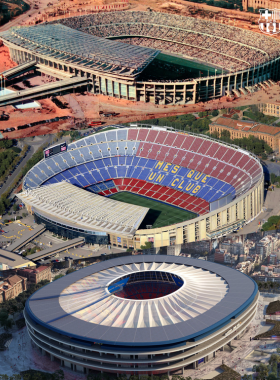
Camp Nou
Address: Les Corts, 08028 Barcelona,
| Type | Sports, stadium |
| Time to Spend | 1 to 2 hours |
History and Significance: Camp Nou is the home stadium of FC Barcelona and one of the largest football stadiums in the world. Opened in 1957, it has witnessed numerous historic matches, including international events and club milestones.
What to Expect: Expect an unforgettable sports experience, from exploring the FC Barcelona museum to standing on the stadium’s pitch. The museum showcases the club’s rich history, including trophies, memorabilia, and interactive exhibits.
Visitor Information: Camp Nou is located in the western part of Barcelona. The stadium offers daily tours, but it’s best to check the schedule for availability. Tickets are available online, and the museum is open daily from 10 AM to 6 PM.
Football fans won’t want to miss Camp Nou, the stadium of FC Barcelona. With a capacity of nearly 100,000, it’s the largest stadium in Europe. Visitors can tour the stadium and learn about the club’s history in the FC Barcelona Museum. Even if there isn’t a game on, the stadium’s energy and the passion of the fans are worth experiencing. It’s a memorable stop for sports enthusiasts, giving you a glimpse into one of the world’s most beloved football clubs.
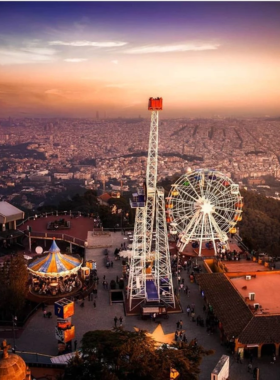
Tibidabo Amusement Park
Address: Pl. del Tibidabo, 3, 4
| Type | Parks & Gardens |
| Time to Spend | Half Day |
History and Significance: The Picasso Museum in Barcelona houses one of the largest collections of artworks by the famous Spanish artist, Pablo Picasso. The museum showcases his early works, providing insight into his artistic development.
What to Expect: Expect to see a diverse collection of paintings, sketches, and ceramics by Picasso, including pieces from his Blue Period and his later works. The museum is housed in several medieval buildings, enhancing the historical charm.
Visitor Information: Located in the El Born district, the museum opens from 9 AM to 8 PM, closed on Mondays. Tickets are available online or at the door. Admission is free on the first Sunday of each month.
Tibidabo Amusement Park is perched on a mountain, offering rides with views of Barcelona below. This vintage park has rides for all ages, including a Ferris wheel, a roller coaster, and classic carnival games. The park also offers beautiful views from the Sagrat Cor Temple nearby, a picturesque church at the mountain’s peak. For a fun day trip from the city, Tibidabo combines thrill rides with some of the best viewpoints in Barcelona.
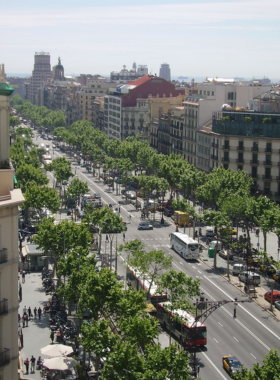
Passeig de Gràcia
Address: Passeig de Picasso, 21
| Type | Free, Neighborhood/Area |
| Time to Spend | 1 to 2 hours |
History and Significance: Tibidabo is a mountain overlooking Barcelona and is home to the famous Temple of the Sacred Heart. The mountain has an amusement park, historical sites, and the stunning panoramic view of the city below.
What to Expect: Expect a relaxing day of sightseeing, with options to visit the church, enjoy the amusement park, or hike to the top of the mountain. The views from the summit are extraordinary, offering the perfect vantage point of the entire city.
Visitor Information: Tibidabo is accessible via a funicular, car, or bus. The amusement park operates from 11 AM to 6 PM, and the temple is open for visits from 10 AM to 1:30 PM. You can also enjoy hiking trails in the surrounding area.
Passeig de Gràcia is one of Barcelona’s most luxurious streets, featuring upscale shops, boutiques, and cafes. The avenue is home to famous architectural landmarks like Casa Batlló and Casa Milà, making it a blend of shopping and sightseeing. Walking along Passeig de Gràcia, you’ll find beautiful facades, intricate ironwork, and mosaics. It’s an ideal spot for a leisurely stroll, window-shopping, or simply taking in the art nouveau charm of this stylish boulevard.
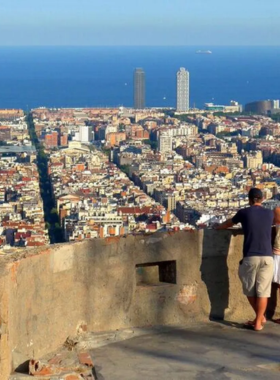
Bunkers del Carmel
Address: Carrer de Marià Labèrnia,
| Type | Museum |
| Time to Spend | 1 to 2 hours |
History and Significance: Poble Espanyol is an open-air museum that showcases Spanish architecture, crafts, and culture. Built in 1929 for the International Exposition, it features replicas of various Spanish buildings and a variety of workshops.
What to Expect: Expect to experience the diversity of Spain through replicas of streets, squares, and buildings from different regions. You can visit artisan workshops, taste Spanish food, and enjoy cultural performances.
Visitor Information: Poble Espanyol is located on Montjuïc Hill and is open daily from 10 AM to 8 PM. Tickets can be bought online or at the entrance. The village is family-friendly and offers many activities for children.
Bunkers del Carmel offers a relaxed, panoramic viewpoint popular with locals, especially at sunset. Originally built as anti-aircraft bunkers during the Spanish Civil War, these overlook Barcelona, offering stunning views of the city’s skyline. It’s a favorite spot for photographers and sunset-watchers alike. Grab a picnic, make the short hike up, and enjoy the scenery. This hidden gem lets you experience a quieter side of Barcelona with breathtaking views.
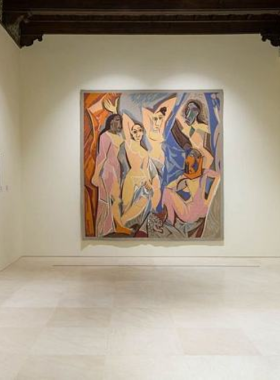
Museu Picasso
Address: Montcada, 15-23
| Type | Museums |
| Time to Spend | 1 to 2 hours |
History and Significance: The Barcelona Aquarium is one of Europe’s largest marine centers, showcasing Mediterranean and tropical sea life. It provides educational insights into marine conservation and biodiversity
What to Expect: Expect an underwater adventure, with numerous sea creatures, including sharks, turtles, and exotic fish. The highlight is the transparent tunnel that lets visitors walk through a giant tank filled with marine life.
Visitor Information: Located in Port Vell, the aquarium is open daily from 10 AM to 8 PM. Tickets are available online and at the entrance. The aquarium offers special activities for children and educational programs for school groups.
Dedicated to the works of Pablo Picasso, this museum is a must-visit for art lovers. The museum holds an extensive collection of his early work and is located in the historic El Born neighborhood, known for its medieval charm. Walking through the museum’s galleries, you’ll see how Picasso’s style evolved and catch glimpses of his formative years in Barcelona. The museum also hosts special exhibitions and events, making it an enriching experience for art enthusiasts.

